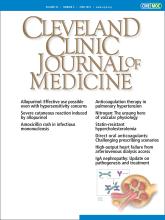COVID-19 Curbside Consults
Update to post-acute sequelae of SARS-CoV-2 infection: Caring for the 'long-haulers'
Susan Vehar, MD, Marina Boushra, MD, Prince Ntiamoah, MD and Michelle Biehl, MD, MS
Cleveland Clinic Journal of Medicine October 2021, DOI: https://doi.org/10.3949/ccjm.88a.21010-up
Susan Vehar
Department of Critical Care Medicine; Department of Pulmonary Medicine; Cleveland Clinic, Cleveland, OH
Marina Boushra
Department of Critical Care Medicine, Cleveland Clinic, Cleveland, OH
Prince Ntiamoah
Department of Critical Care Medicine; Department of Pulmonary Medicine; Cleveland Clinic, Cleveland, OH
Michelle Biehl
Department of Critical Care Medicine; Department of Pulmonary Medicine; Cleveland Clinic, Cleveland, OH
In this issue
Cleveland Clinic Journal of Medicine
Vol. 92, Issue 6
1 Jun 2025
Update to post-acute sequelae of SARS-CoV-2 infection: Caring for the 'long-haulers'
Susan Vehar, Marina Boushra, Prince Ntiamoah, Michelle Biehl
Cleveland Clinic Journal of Medicine Oct 2021, DOI: 10.3949/ccjm.88a.21010-up
Jump to section
Related Articles
- No related articles found.
Cited By...
- No citing articles found.






